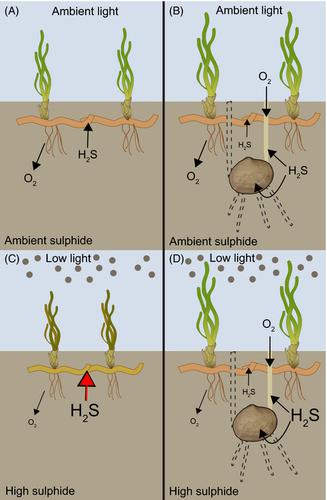Our official English website, www.x-mol.net, welcomes your feedback! (Note: you will need to create a separate account there.)
Facilitation of a tropical seagrass by a chemosymbiotic bivalve increases with environmental stress
Journal of Ecology ( IF 5.5 ) Pub Date : 2020-07-02 , DOI: 10.1111/1365-2745.13462 Diana W. Chin 1, 2 , Jimmy Fouw 3 , Tjisse Heide 3, 4, 5 , Brianna V. Cahill 1, 6 , Kevin Katcher 7 , Valerie J. Paul 2 , Justin E. Campbell 2, 8 , Bradley J. Peterson 1
中文翻译:

化学共生双壳类对热带海草的促进作用随环境压力的增加而增加
更新日期:2020-07-02
Journal of Ecology ( IF 5.5 ) Pub Date : 2020-07-02 , DOI: 10.1111/1365-2745.13462 Diana W. Chin 1, 2 , Jimmy Fouw 3 , Tjisse Heide 3, 4, 5 , Brianna V. Cahill 1, 6 , Kevin Katcher 7 , Valerie J. Paul 2 , Justin E. Campbell 2, 8 , Bradley J. Peterson 1
Affiliation

|
- Facilitation of foundation species is critical to the structure, function and persistence of ecosystems. Understanding the dependence of the strength of this facilitation on environmental conditions is important for informed ecosystem management and for predicting the impacts of global change. In coastal seagrass habitats, chemosymbiotic lucinid bivalves can facilitate seagrasses by decreasing potentially toxic levels of sulphide in sediment porewater. However, variation in the strength of lucinid–seagrass facilitation with environmental context has not been experimentally investigated.
- We tested the hypothesis that the presence of the tiger lucine Codakia orbicularis becomes more important to the growth and survival of the seagrass Thalassia testudinum under decreased light availability and increased sulphide stress. In a mesocosm experiment, we reduced average ambient‐light to T. testudinum by 64% and/or increased sediment porewater sulphide concentrations by ~200% and compared growth and tissue chemistry of T. testudinum with and without C. orbicularis.
- We found that T. testudinum was better able to maintain growth under shading and sulphide stress when C. orbicularis was present. C. orbicularis strongly decreased sediment porewater sulphide, an effect that minimized sulphur build‐up in seagrass tissue and was likely achieved through bioirrigation as well as chemoautotrophy. The relative effects of C. orbicularis on T. testudinum growth were strongest in the presence of environmental stressors.
- Synthesis. The strength of lucinid–seagrass facilitation increases under environmental conditions that hinder the ability of seagrass to detoxify sulphide. Our results provide evidence of a potential mechanism by which the spatiotemporal association between lucinids and seagrasses is maintained and support the incorporation of interspecific facilitation into conservation and restoration strategies for foundation species in the face of increasing anthropogenic impact and global change.
中文翻译:

化学共生双壳类对热带海草的促进作用随环境压力的增加而增加
- 基础物种的便利化对生态系统的结构,功能和持久性至关重要。理解这种便利的强度对环境条件的依赖性对于进行明智的生态系统管理和预测全球变化的影响非常重要。在沿海海草的生境中,化学共生亮藻类双壳类动物可以通过降低沉积物孔隙水中潜在的有毒硫化物含量来促进海草生长。但是,尚未通过实验研究在环境条件下亮度-海草促进强度的变化。
- 我们测试的假设老虎lucine存在Codakia眼轮匝变得对海草的生长和存活更重要Thalassia testudinum下降低光的可用性和硫化物应力。在一个围隔实验中,我们降低的平均环境光到T. testudinum 64%和/或通过〜200%增加沉积物孔隙水硫化物浓度和比较的生长和组织化学T. testudinum有和没有C.眼轮匝。
- 我们发现,当存在圆形隐球菌时,睾丸丙种能更好地在阴影和硫化物胁迫下保持生长。C.眼轮匝强烈降低沉积物孔隙水硫化物,即海草组织中最小化硫积聚和通过bioirrigation以及化能自养很可能达到的效果。在存在环境胁迫因素的情况下,圆弧菌对睾丸毛虫生长的相对影响最强。
- 综合。在环境条件下,褐藻类-海草促进作用的强度会增加,从而阻碍了海草对硫化物的解毒能力。我们的结果提供了证据,证明了维持亮藻类和海草之间的时空关联的潜在机制,并支持在人类活动影响和全球变化日益加剧的情况下,将种间便利化纳入基础物种的保护和恢复策略。



























 京公网安备 11010802027423号
京公网安备 11010802027423号